Introduction
Haworthia Revisited was drafted in 1996, and since then the first author has undertaken a number of field excursions in an attempt to clarify uncertainties. The putative nature of species of Haworthia as recognised by Bayer (listed in Haworthia Revisited, Umdaus 1999) and the importance he attached to geographic distribution are stressed in all his publications. This is because these so-called species seem to vary continuously with one another in that context of geography. Classification seeks to portray relationships and origins. Hence when a species has been recognised, a cognitive attempt has been made to speculate on phylogenetics, where distribution must be significant. In the case of Haworthia floribunda this proves rather difficult, and this article is a discussion of the relationship of this species to its possible relatives. The point we do make is that the Linnaean binomial system, as well as cladistic methods, seem neither to deal with nor portray the problem of reticulate relationships. In other words, the nomenclatural system and the way we classify plants and analyse their relationships assumes linear dichotomy in those relationships.
Considerations
H. floribunda was described by von Poellnitz in 1938. It was preceded by H. parksiana in 1936. Other species which need to be considered are H. chloracantha Haw. (1821), H. variegata Bol. (1929), H. magnifica VPoelln. (1933) and H. maraisii VPoelln. (1935). Each of these species, although H. parksiana to a lesser degree, has complex variability within assignable geographic space. The difference with H. floribunda is that it is peripheral to all of them.
Bayer, in his Haworthia Handbook (1976), writes of H. floribunda ” … It is not certain what the relationship is between this species and H. chloracantha var. denticulifera which is found north and south of Albertinia on the west of its distribution range. Thus H. chloracantha abuts on H. floribunda and may be geographically continuous with it.” In the New Handbook (1982) Bayer writes “There is a known population north of Albertinia in which the plants have more and shorter leaves, as well as another similar population near Gouritzmond. These two populations may suggest an affinity with H. chloracantha (here an unpublished comment by A.E Speechley is added which probably has its origins in Bayer’s note of 1976, or in private communication between the two persons). There may be such a relationship, but it seems likely that H. floribunda and H. parksiana are in fact related. They both tend to grow well‑shaded and in moss and lichen.”
The problem is not resolved in Bayer’s more recent revision (1999). He does recognise three varieties of H. floribunda. These are:
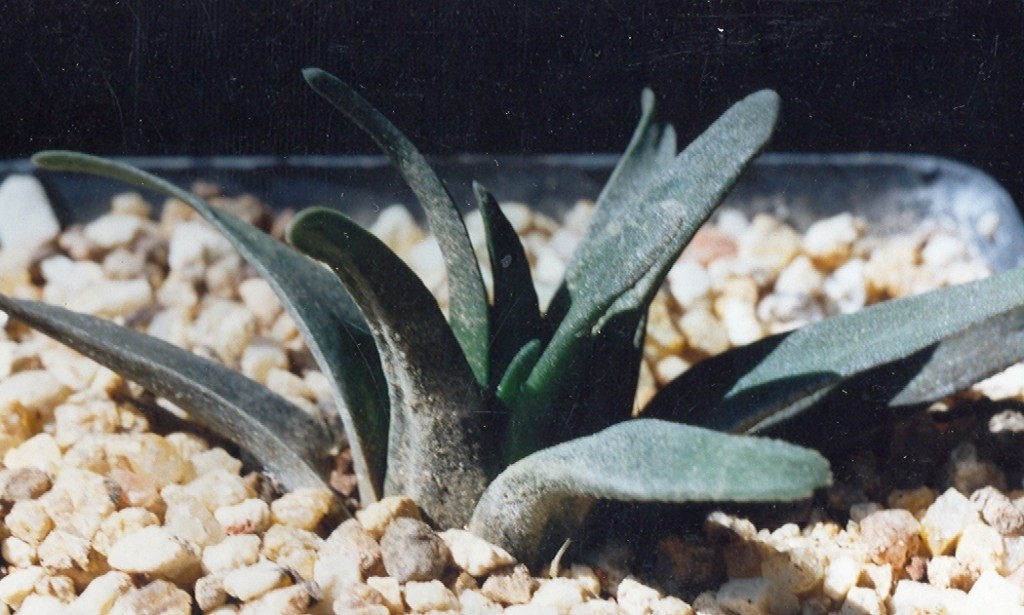
a. the typical one comprising a single population north of Heidelberg (Fig.1 MBB158).
b. a similar single population near Swellendam representing the var. major (Figs.2a & b MBB6859).
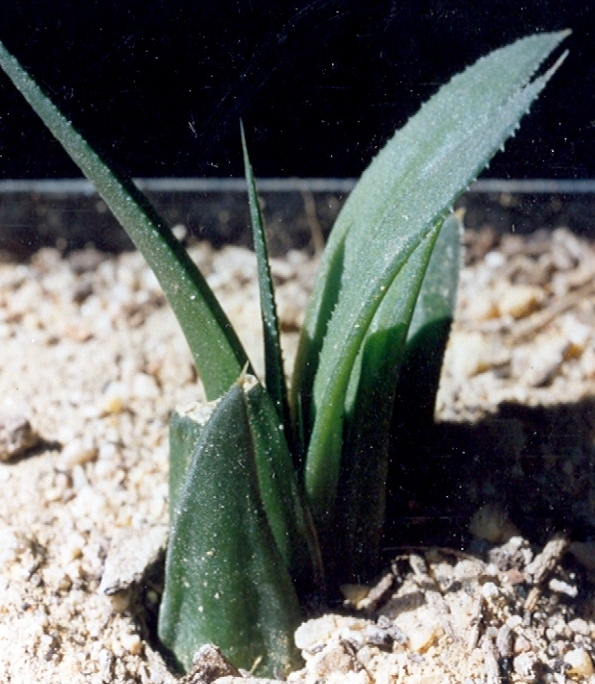
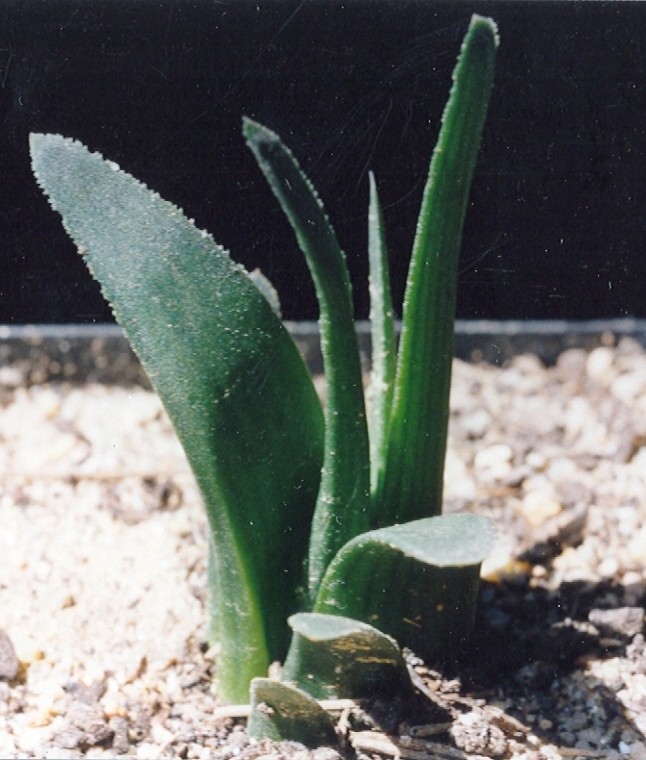
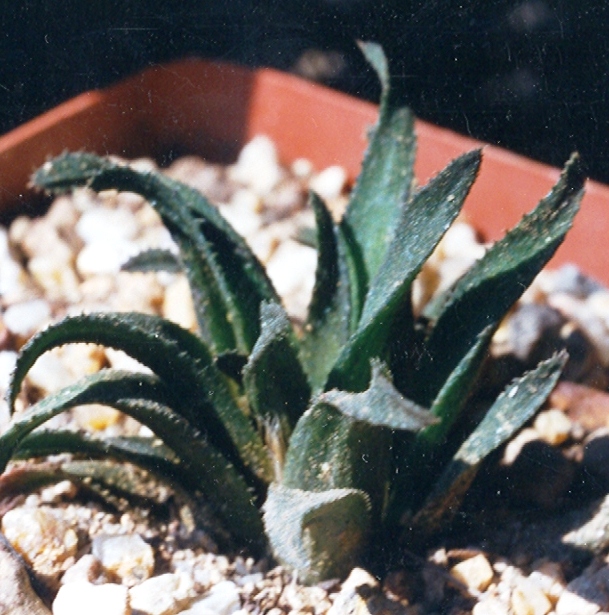
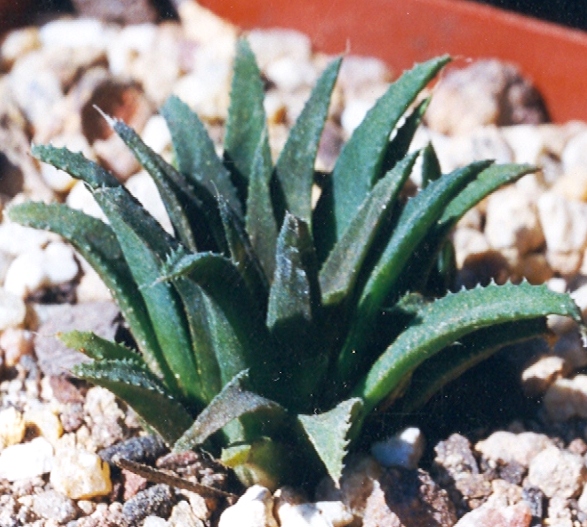
c. the remainder, the var. dentata (Figs.3a & b JDV89/17).
In the discussion of H. chloracantha, it is also stated that a population north of Albertinia (i.e. Draaihoek, Fig.4 MBB2311) considered as chloracantha in 1976, considered non-commitally as chloracantha in 1982; ” … includes plants which resemble H. parksiana and it may best be related to H. floribunda“. This collection is cited under H. floribunda var. dentata. Thus there is a degree of uncertainty for which the author offers an apology, and here attempt to summarise the situation a little more comprehensively.
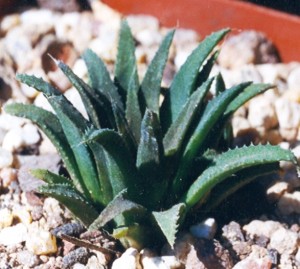
There are some red herrings in various comments made by Bayer. These include reference on p48 of Haworthia Revisited to the lower Gouritz population (Fig.5 MBB5460) “previously being assigned to H. floribunda“, possibly referring to a Smith identification on a photograph and cited under H. chloracantha var. denticulifera. There is a similar population nearer Albertinia (Fig.6 MBBsn). Also there is a citation of a specimen from the Duiwenhoks Causeway (Muller-Doblies 89/098) under H. chloracantha var. denticulifera, which may be the same population sampled by Venter and Esterhuizen (Figs.7a & b JDV92/31) from a site named as Dassieklip also on the Duiwenhoks River (the geographical grid references differ and these may be incorrect), but cited under H. floribunda var. dentata.
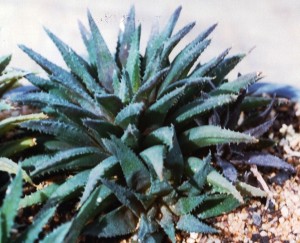
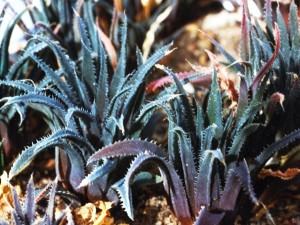
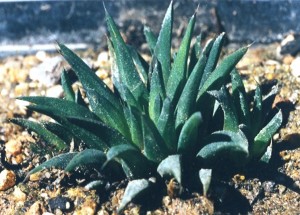
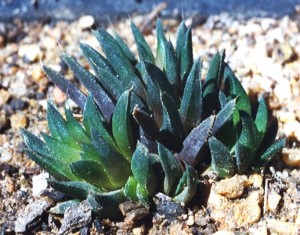
Haworthia parksiana is known from at least five different sites of which two are recorded by Mr Jan Vlok, viz. at Outeniqua Siding, and north-east of Brandwacht, Mossel Bay. No herbarium specimens of these are known to have been lodged. J.D Venter has commented that parksiana-like seedlings were grown from H. magnifica seed (parent plants ex near Heidelberg). It is doubtful if this can be used to support a claim that this is the origin or relationship of the two species. Bayer has also grown small stunted forms of magnifica from seed of an H. magnifica population south of Riversdale. Such dwarfed individuals have been observed among seedlings derived from other populations. The connection of H. magnifica to the Mossel Bay area is just too tenuous. At Albertinia itself we have the variation to H. magnifica vars. dekenahii and splendens, while to the south west we have the var. acuminata. This is assuming that Bayer is correct in making these combinations which are known to be complicated by consideration (among many) of H. emelyae north of the Langeberg mountains.
H. chloracantha is treated in Haworthia Revisited, as three varieties. The typical variety is considered to consist of the known single population north of Herbertsdale (Bayer in KG411/75). However, Paul Vorster drew my attention to a population at the Wolwedans Dam north of Great Brak which is almost identical and which invalidates varietal distinction defined by geographical considerations (Fig.8 MBB7425). A specimen of this collected by C Burgers is also cited for the Gouritz Gorge where it exits the Langeberg Mountains. P.V.Bruyns and E.A.van Jaarsveld have also made collection from further north in the same gorge, which are uncited. These three populations cannot be categorically included in the typical variety and could be just as at home in the var. denticulifera. The only consideration is probably size and the greenish colour – as opposed to the usually smaller and purplish-green of the var. denticulifera. The var. sub-glauca also does not have a clear geographical base in terms of difference or distribution range, and may just be a much localised ecotype in the vicinity of Great Brak. It occurs close to the Wolwedans population both to the south and to the west. The recognition of these varieties makes it a little difficult also to include the Albertinia and Cooper Siding populations as cited in Haworthia Revisited under H. chloracantha as they are so closely similar, and located, to H. floribunda. The geographical considerations, however, argue for their inclusion.
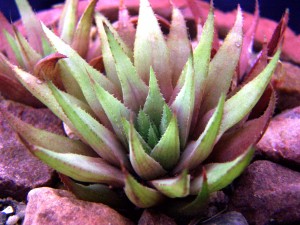
The Great Brak/Mossel Bay area contains some endemic species which suggest the operation of a mechanism which could have isolated the vegetation of that area at some time in the past. H. parksiana, H. kingiana, H. pygmaea, H. chloracantha and species like Euphorbia bayeri and Duvalia immaculata suggest this. The Langeberg mountains are an east/west barrier separating the more arid Little Karoo and its succulent Karoid vegetation from the Southern Cape where Renosterveld and Karoid Valley Bushveld are more strongly represented. The Gouritz River Gorge may have been, or is, a similar north/south divide. Westwards, the Swellendam area seems to provide a vegetation interval that H. turgida seems to bridge with difficulty, and which also marks some kind of a break for the H. magnifica/H. maraisii complex. This divide may be a function of inadequate collecting or the lack of adequate habitat. The Breede River valley may, like the Gouritz, present a north/south barrier. It is the home for H. venosa subsp. venosa and also for an endemic asclepiad Stapeliopsis stayneri. West of Swellendam is also the start of the Worcester Robertson Karoo which is vegetatively much closer to the Little Karoo than is the eastern part of the Southern Cape. This area also has its own Haworthia endemics or near-endemics.
The physical commonalities of the three species floribunda, chloracantha and parksiana, are that the leaves are in a stemless rosette, having from 20-40 leaves per rossete. The lowest numbers are in floribunda with parksiana and chloracantha generally having more. The leaves are firm and slightly scabrid. H. chloracantha is more spinose than the other two species and the leaves are triangular in cross-section with a conspicuous keel. In H. parksiana the leaves tend to be short and sharply recurved. In H. floribunda the leaves are more erect, although spreading. Characteristically the leaves are twisted and there is no keel, so the leaf is more effectively strap-shaped particularly towards the apex. The leaf-tip is also rounded with a short point. In H. chloracantha, the leaves are erect and spreading, not twisted. They are keeled and thus triangular in cross section. The leaf tip is attenuated and pointed. The leaf surfaces of the three species are variable. Both H. floribunda and H. parksiana can exhibit quite tuberculate surfaces, although parksiana never has the relatively glabrous surface that may occur in either chloracantha or floribunda. Colouration is also variable across the three species, although parksiana does not occur in the lighter colours that the other two species may exhibit. A hatched pattern of the under-leaf surface may appear. All three species make offsets although parksiana is slower and more reluctant to do so – an observation which may just be peculiar to the individual grower and the clones he has under his conditions.
New material
Regarding H. parksiana, the only new records are those of Jan Vlok mentioned above. The writers assume that the identifications are correct and that they establish the discrete identity of that species. Regarding H. chloracantha, there is only one significant new collection. This is one of the var. denticulifera made by Bayer, Kent and Venter. It was made at the same time as a visit to the site of the typical var. chloracantha north of Herbertsdale. Here the plants are on a very steep clay slope (in fact recent rains had caused massive mud-slides). The plants are quite large and form immense chlorotic-green clumps. We were at Herbertsdale to verify a collection of H. pygmaea made by Ernst van Jaarsveld in the same vicinity. This is a short distance away on a steep conglomerate slope. H. pygmaea was present on the dry northern edge. But in the moss and lichen of the cooler eastern overhang were the small single plants of H. chloracantha (Figs.9a, b & c JDV97/136). These were so evidently different from the typical form that we accepted (with reservation) the identification as H. floribunda. One reason for such identification is simply one of informal communication. A similar “floribunda“-like plant grows with H. pygmaea and H. parksiana virtually within Great Brak Township (Fig.10 JBouwer sn). This was collected and referred to as H. floribunda by both messrs. H. Gie and J. Bouwer. It is possible, and probable, that it is in fact H. chloracantha var. denticulifera, as is the new population JDV97/136.

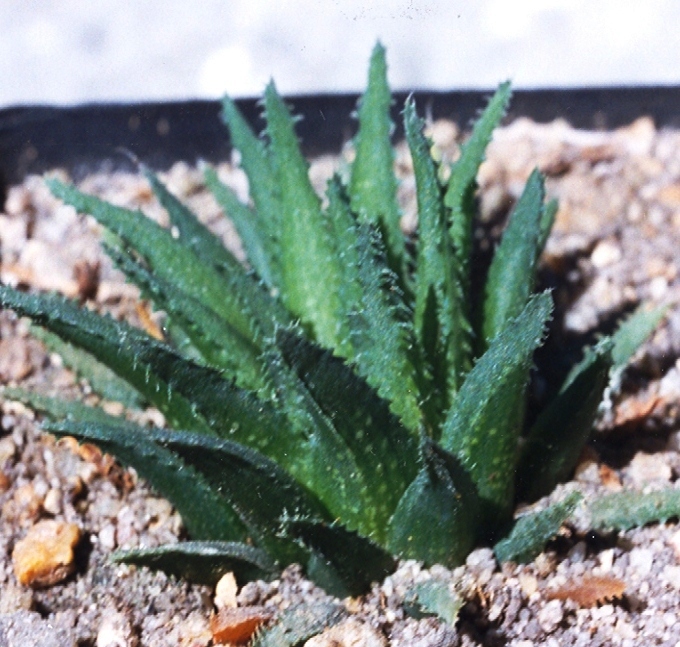
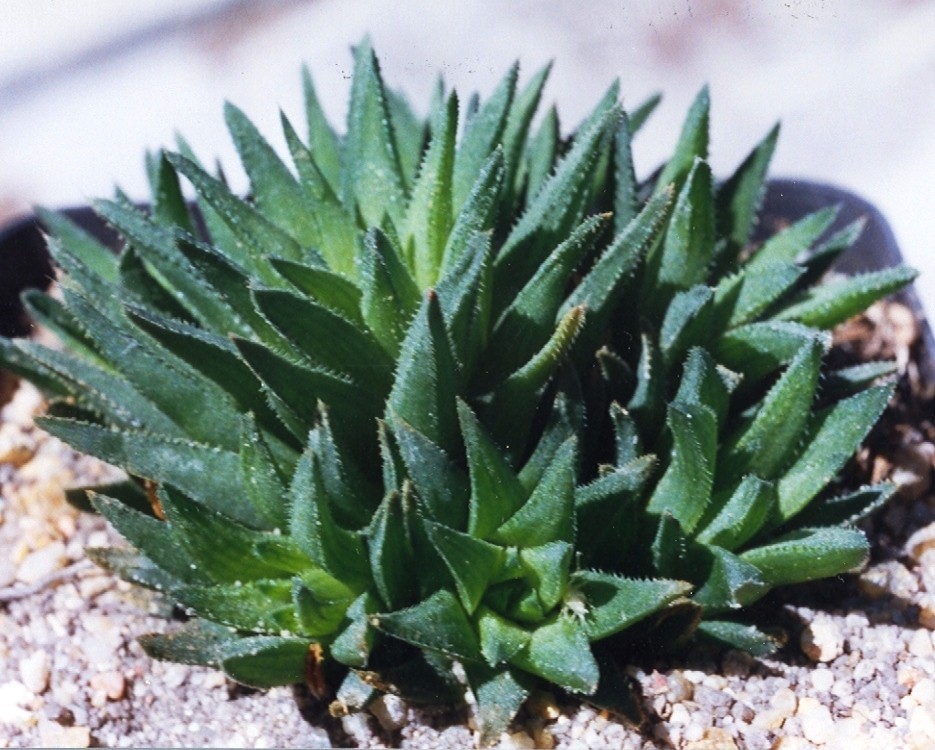
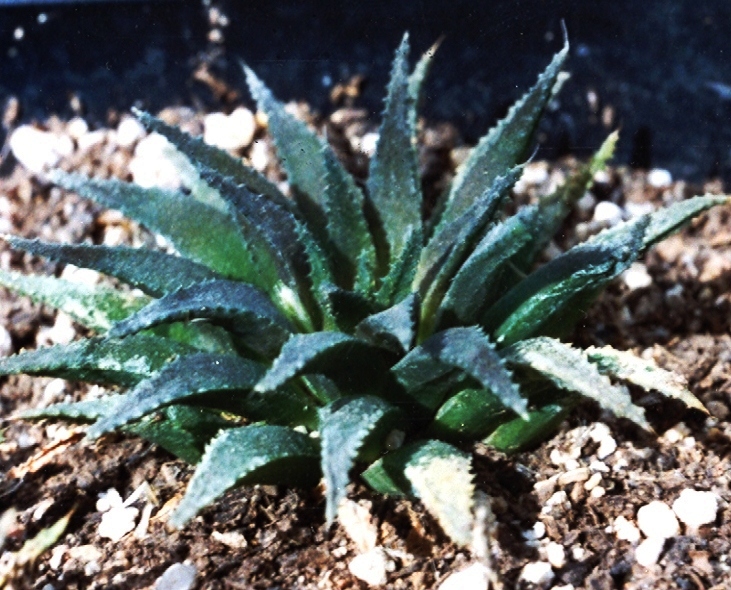
The Dassieklip population (Fig.7) remains somewhat of an enigma. A good comparison can even be made with collection of H. monticola from Trompetters Poort, north of Willowmore, as the plants also have an apparently smoother epidermis than appears evident in chloracantha. This is a highly improbable relationship, but it is necessary to make this comparison in view of what has been speculated elsewhere about the possibility of a continuation between H. chloracantha, H. variegata and H. monticola (H. divergens Bayer!). This speculation has been by Bayer and is not significant enough to cite in detail. What is important is that the Dassieklip population may in fact be closer to H. variegata. Hence its citation under both H. chloracantha and H. floribunda is unavoidably misleading. However, that can only be considered in a detailed evaluation of H. variegata in its relationship to the coastal limestones and re-occurrence in shales both west and south of Swellendam.
The newest finds relating to H. floribunda are in the broad area southwest of Heidelberg, and west of Bredasdorp. However, there is one new record by E. Aslander of plants from northeast of Albertinia (Figs.11a, b & c EA1238) in which plants very clearly have the characteristics of H. floribunda. There are also individuals with the leaves of H. chloracantha. There is another collection by Aslander from Snymanskraal west of Albertinia (Figs.12a & b JDV92/2) which resembles the Draaihoek sample and thus may also be H. chloracantha var. denticulifera. A further collection by J.D. Venter is midway between this collection and Riversdale (Figs.13a, b, & c JDV93/56), and is clearly H. floribunda. A feature of this collection is the striated rugosity of the leaf surface in some clones and also the occurrence of short, almost terete, leaves that are evident in a clone of H. parksiana in a JDV collection.

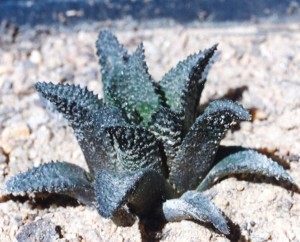
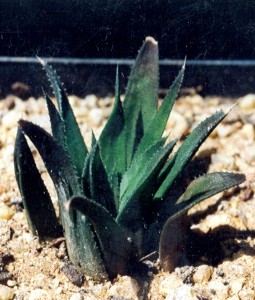
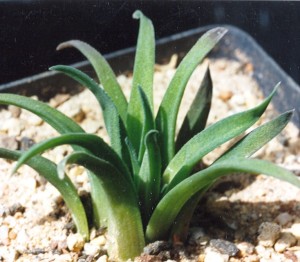
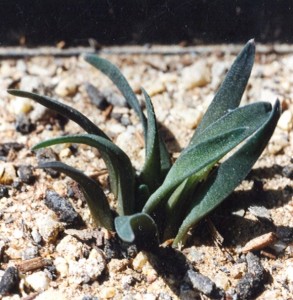
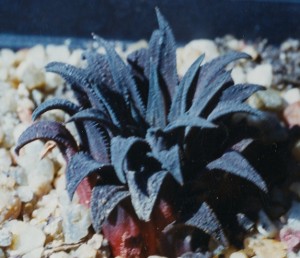
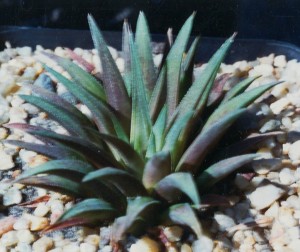


Collections from the western areas include:- from a population reported by E. Esterhuizen on the farm Koppies, southeast of Swellendam (Figs.14a, b & c MBB6879) where the plants tend to H. maraisii; from slightly to the east and south of this at Oudekraal (Figs.15a, b, c & d MBB6881) the plants are very like H. floribunda var. dentata as it occurs at Buffeljachts and at the Bontebok Park south of Swellendam. Esterhuizen commented on the appearance of the twisted and flattened leaf-end of H. maraisii north of Bredasdorp. This is confirmed in populations at Napky (MBB7030) and at Adoonskop (Figs.16a, b & c MBB6640) Adoonskop (maraisii) where the plants do indeed look like very robust forms of floribunda. The same characteristic twisted and rounded leaf-tip is evident in maraisii at Napier (Figs.17a, B & c MBB6973) and especially in the seedlings.
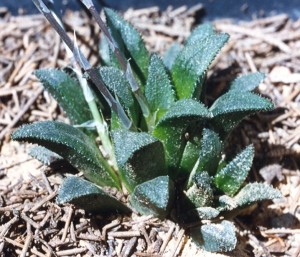
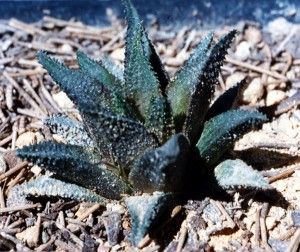
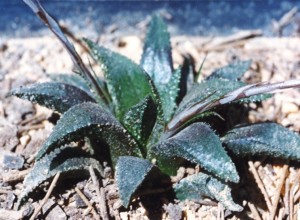

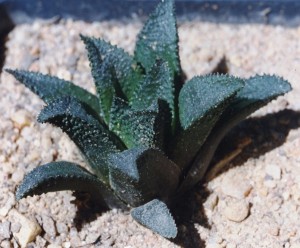
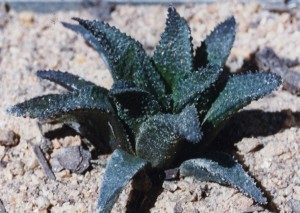
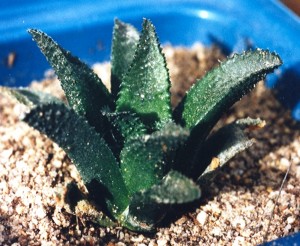
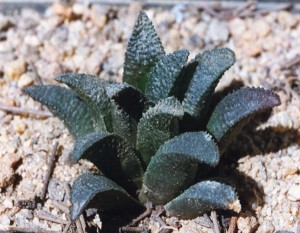
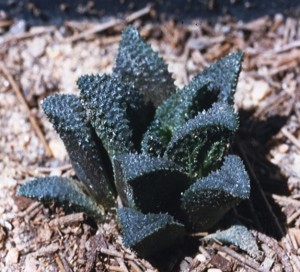
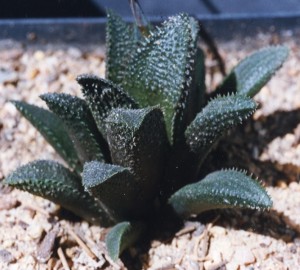
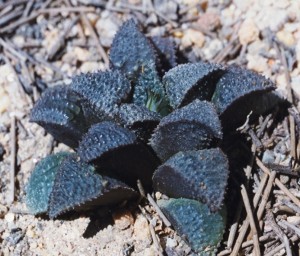

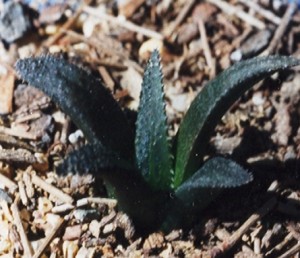
Several other collections confound the picture completely either because of intrinsic variability or because they make it difficult to uphold any geographical recognition of variation. Firstly there is a collection attributable to P.V. Bruyns, north of DeHoop (Figs.18a, b & c MBB6539) which has strong resemblance to H. magnifica var. atrofusca.
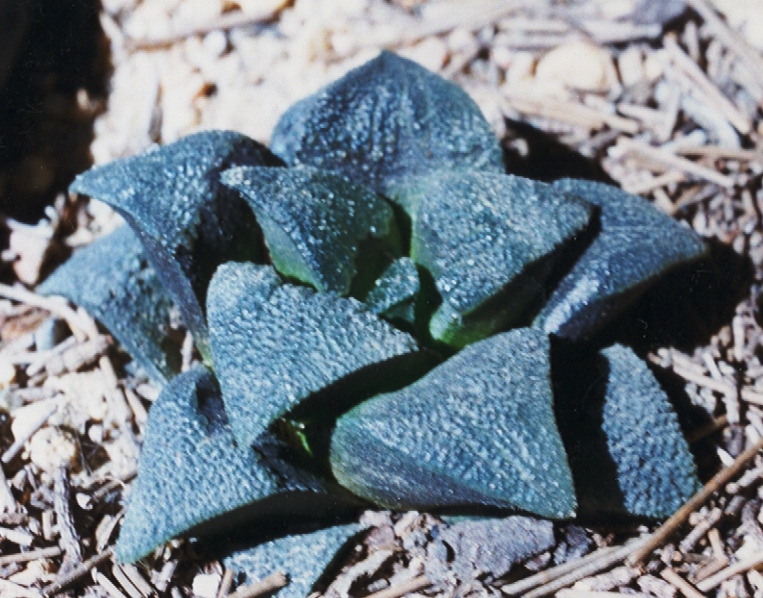
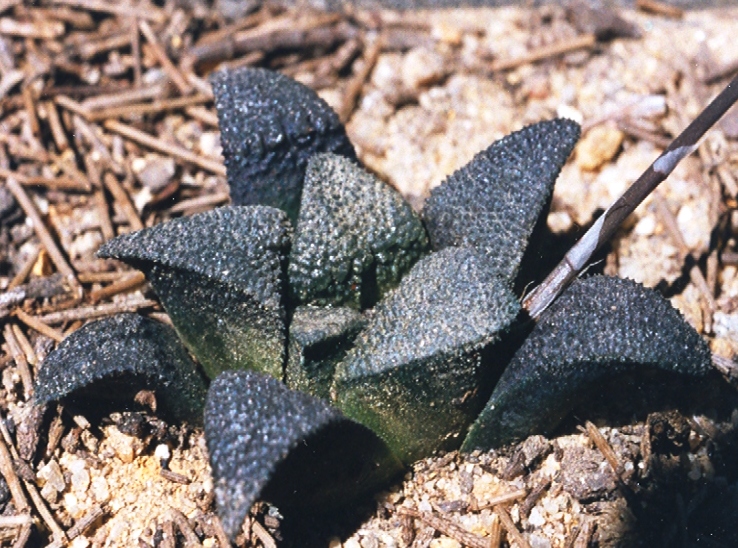
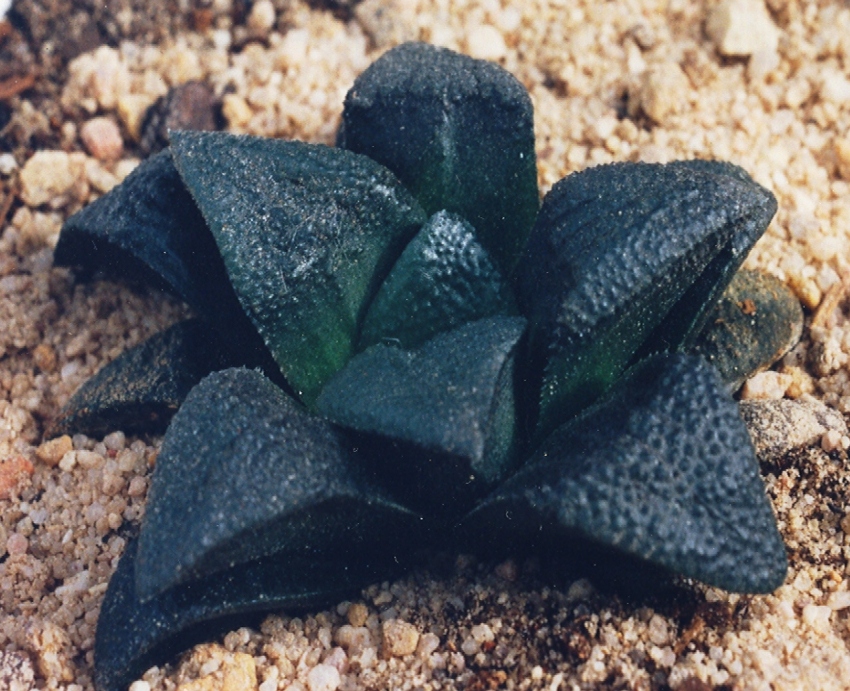
Secondly there is a series of populations from the northwestern end of the Potberg, south of Swellendam and east of Bredasdorp. These are:- Juliesfontein (Figs.19a, b, c & d MBB6882); Brakfontein (Figs.20a, b, c, d & e MBB6886); northern Potberg slopes (Figs.21a, b & c MBB6889); and north of Brakfontein (Figs.22a & b MBB6890). These complement collections Burgers 2506, Bayer in KG35/70 and Bruyns in KG49/76 cited in Haworthia Revisited under H. maraisii, as well as MBB(PVB)6544 (Figs.23a & b), and MBB6545 (Figs.24a & b) cited under H. heidelbergensis var. scabra.
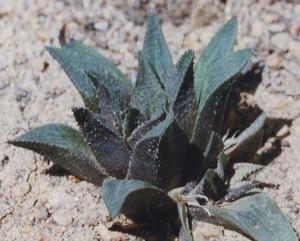


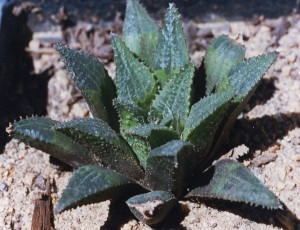
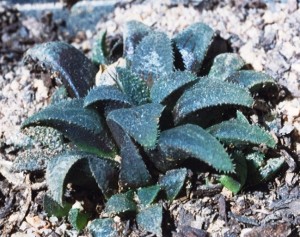

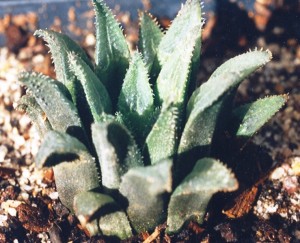

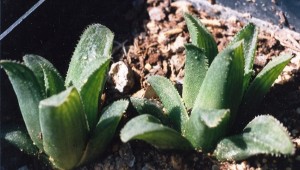

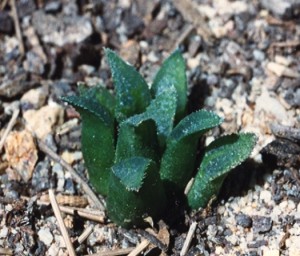
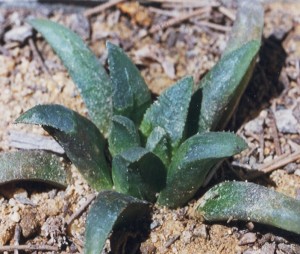
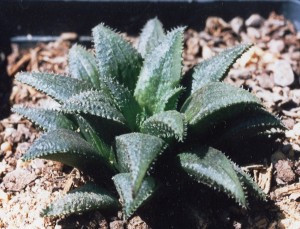

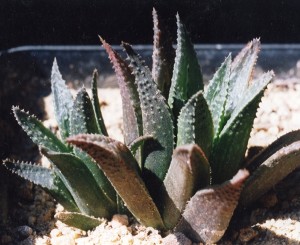
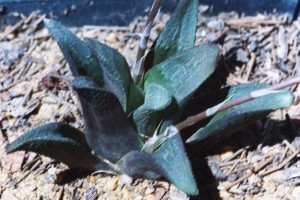
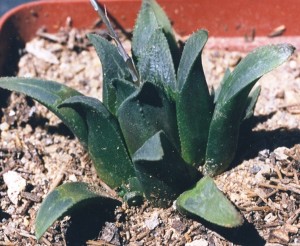
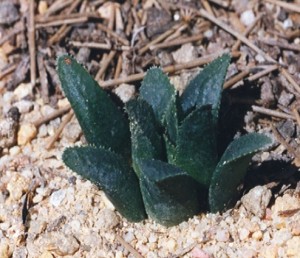
The influence of other species such as H. mirabilis, H. variegata and H. serrata are in evidence. It can be noted that KG35/70 was of very small plants at Juliesfontein. Returning to the same site 30 years later I could not find these small plants at the original site, and instead found the bigger plants of MBB6882 a short distance away. There are three more collections to be considered:- by Denis DeKok near Swellendam (Figs25a, b & c MBB6644), about 10km west of Swellendam (MBB6861), and from the farm Rondeheuwel south of Stormsvlei (Figs.26a, b & c MBB6882, Bayer in KG326/71). This latter collection has previously been reported (Haworthia Handbook 1976) under one of the populations intermediate with H. mirabilis, and is cited in Haworthia Revisited under H. maraisii. These populations, as well as that southwest of Heidelberg (KG107/74 cited under H. magnifica (Figs.27a,b & c MBB6663, Bayer in KG107/74) confound the issue enormously as we actually have four populations which cannot with confidence be allied with either H. magnifica, H. maraisii or with H. mirabilis. The reality is that neither H. heidelbergensis nor H. floribunda can be excluded from the consideration of these populations. The case for each “species” needs to be dealt with separately. In this case, H. floribunda is reflected in the nature of the leaf shapes. In all the four latter populations given, there are individuals which have the same characteristic leaf shape of H. floribunda, although not necessarily the elongated strap-like leaves of the typical form. In addition to this, seedlings of many different collections of H. magnifica (Kweekkraal, Figs.28a & b MBB6817 – and the reader should refer to the chapter where interplay between H. magnifica and H. floribunda is reported), H. maraisii, H. heidelbergensis, H. mirabilis (Goudini, Caledon, Fig.29 MBB6537), and even H. mutica (Hasiesdrift, Fig.30 MBB6982), have the floribunda-like shape evident in the young leaves. Kobus Venter was especially struck by this phenomenon while photographing H. mirabilis on the Bromberg Mountain near Stormsvlei. These rounded obtuse leaf-tips are maintained until at least the three to five-leaf stages and then largely disappear. Thus there seems to be a distinct sign that the leaf-type is juvenile and that H. floribunda represents a “species” with retained juvenile characters. This may extend to the fact that the seedlings of this species also seem to remain slightly distichous for longer than is the case in other species. In the case of H. floribunda var. major from southwest of Swellendam, the leaves in some individuals may be fully pointed and triangular in cross-section and thus more closely resemble plants in the population of H. variegata var. hemicrypta west of Swellendam. This is the same kind of variation found in the populations about Albertinia, where the speculated differentiation to H. chloracantha occurs.
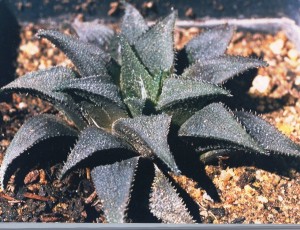
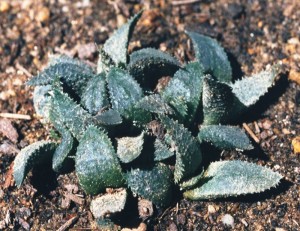

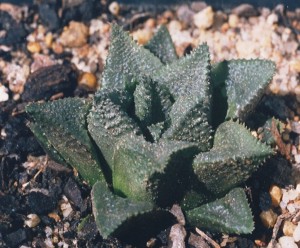
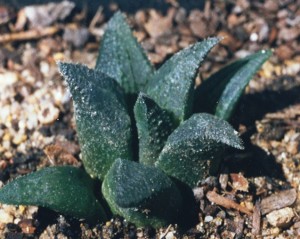
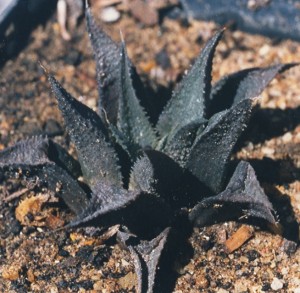
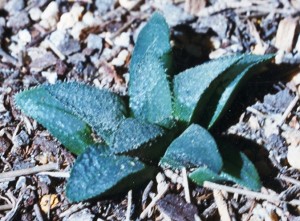

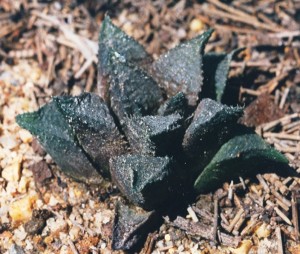

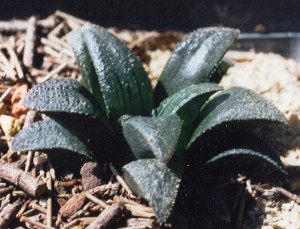
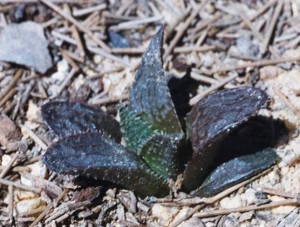
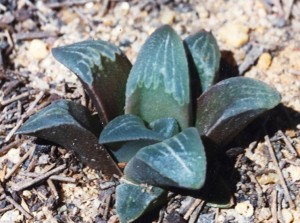
Flower morphology and flowering time does not appear to offer any solutions. As it is, the flowers have so far been shown in Haworthia to be useful only in so far as recognising the sub-genera is concerned. It can be shown that even at that level, the distinction causes problems for botanists. Most of the species discussed above flower in late summer. While the epithet ‘floribunda‘ was chosen to suggest many-flowered, this is true for other populations considered to be H. magnifica.
Conclusion
The circumscription of H. floribunda remains obscure and the situation is in fact exacerbated by new samples which indicate the labyrynthine relationships with several species previously excluded from debate. H. floribunda may have juvenile characters. It does have distinctive populations in a recognisable geographic area. It does not directly share habitat with any species although it does occur very near to H. turgida (north of Heidelberg, where hybrids are also recorded). Where the chloracantha-like equivalent occurs with H. pygmaea var. argenteo-maculosa at Cooper Siding, hybridisation is also evident. It occurs very near to H. magnifica var. atrofusca northwest of Riversdale, growing on a cool southern slope as opposed to the latter on a hotter north slope. The situation northwest of the Potberg, where as many as seven otherwise apparently discrete species need to be included in the discussion, will be very difficult to explain.
It should be noted in closing that the Heidelberg population MBB6663 (as KG107/74) was instrumental in the initial decision by Bayer in 1976 when H. maraisii and H. magnifica were treated as one under H. maraisii. This was repeated in 1982 when H. magnifica was given its chronological priority over H. maraisii. In Haworthia Revisited these two elements are separated as discrete species and the Heidelberg collection is cited under H. magnifica. This decision was made rather to accommodate the varieties which are attached to them. Thus the additional three collections noted in connection with it viz. MBB6860, MBB6861 and MBB6862 all fall within this same indecisive category.
M.B. Bayer, Cape Town, South Africa
R.W. Kent, Poway, California
♦
